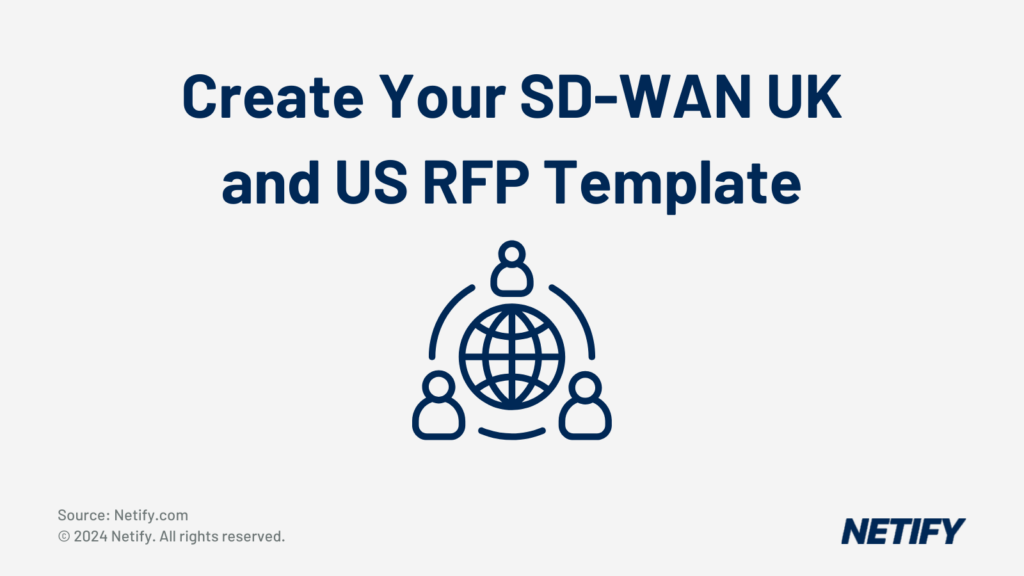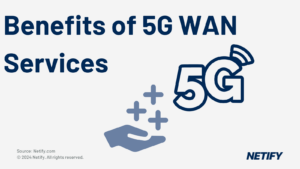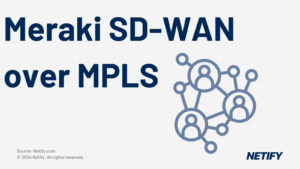| To create an SD-WAN RFP template, you should assess your specific business needs, evaluate provider features and ensure alignment with project goals. |
The creation of an SD WAN RFP template is made simpler when your IT team is fully aware of the key areas to consider together with which providers & vendors are initially a good fit vs your specific business requirements. Netify is positioned to provide everything you need across the RFP process.

IT teams are typically faced with an initial time sink because of the upfront RFP research required to understand which capability appears to fit with strategy, technical & budget. The Netify platform is designed to help with four areas of the RFP creation process.
Table of Contents
1. Dynamic matrices to understand which providers & vendors to select?
The matrices provider assessment features will allow you to quickly examine which providers & vendors are suitable based on your initial input of self-managed, co-managed or fully managed services. Other options include selecting Global services to meet with international requirements, 3rd party MPLS support and 3rd party circuit management. (Above using the Internet as the main VPN backbone)
2. Feature reports across 20 key technology areas IT teams need to consider during the RFP process.
The 20 features are listed further on within this article.
3. Request pre-propsals to set budgets for solutions and network services.
The pre-proposal process is an ideal way to engage SD WAN providers and vendors without the actual need to fully engage in their long sales process. By completing an interactive PDF, our presales team evaluate initial requirements against the Netify knowledge base. We’ll return questions and engage you to think about the areas which are critically important across WAN procurement.
Pre-posals are made up of three key pieces of information:
- Description – Battlecard overview of each SD WAN provider & vendor with their features across network services.
- PrePosal Pitch – An SD WAN pitch on why you should work with each solution offering.
- Pricing Estimate – A cost estimate from the vendor on how much you can expect to pay for both service technology and connectivity.
4. SD WAN RFP template which is created using dynamic matrices and the features which apply to your project.
Netify delivers the data-points for direct input into your RFP process document.

What is the dynamic matrices output with 20 capability data-points across service offerings?
1. Primary Line of Business – is the SD WAN offering based on WAN as a Service, Aggregation, MSP (Managed Services Provider), Carrier service or Cloud provider capability.
2. Focus SD WAN technologies – selected telcos offer support for various SD WAN solutions, each business is listed with their specific platform offerings, e.g application path selection, WAN optimization.
3. Other SD WAN technologies – additional capabilities, e.g. RapidScale supports Citrix NetScaler.
4. Elevator Pitch – an outline of the provider value proposition including the features most represented in their marketing.
5. Is the solution sold standalone – can SD WAN be sold on its own without circuits or other network/cloud services.
6. 3rd party private circuits – does the SD WAN offering work with third party private circuits such as MPLS, VPLS and P2P (Point to Point/Multipoint) circuits?
7. Global coverage – how does the provider or vendor meet international requirements?
8. Differentiators – what are the unique features of each solution, e.g. the platform may support proactive monitoring, networking with next generation security, 100% uptime guarantees.
9. What is the sweet spot across solutions – a list of the ideal opportunity for each provider, e.g. 1-500 sites or domestic only coverage.
10. Bad fits – an outline of poor opportunities for the provider, e.g. a given solution may not be good for Global or specific country locations & coverage.
11. SD WAN architecture – is the solution presented as edge-based, device or network function virtualisation, cloud-hosted with or without PoP coverage.
12. Network Backbone – leading on from architecture, some providers ‘own’ infrastructure to further enhance capability. This is one advantage of major telcos with their PoP locations.
13. Types of circuits – does the provider offer 4G, 5G, Ethernet, Satellite. Internet, Wireless.
14. Aggregated circuits – aside from selling circuits on their network infrastructure, can the provider resell third party circuits such as broadband, cable, 4G & 5G.
15. Circuit management – ability to provide proactive monitoring, effective ticket support resolution, self-service with read/write access to make change request submissions.
16. SD WAN Management – the options for managed services, whether the SD WAN capability is provided as fully managed with read/write access, proactive fault and connectivity management or DIY with self-managed network elements.
17. Proof of Concept (POC) – defined process and terms of any proof of concept across service offerings to test applications and general performance.
18. Proposition launch date – an indication of maturity within the software defined space.
19. WAN customers – the number of connected customer locations indication further insights into experience.
20. WAN sites deployed – the number of actual sites connected is again, a further indication of experience and market presence.
Do you offer rapid site deployment using 4G & 5G?
One of the key SD WAN benefits is delivery of connectivity across multiple service types from 4G to 5G and Broadband through to Ethernet. Fast start is a necessary component of migration to new sites or where temporary services are needed.
Can you include Data Center (colocation), UCAAS (Unified Communications), Cloud and Security service providers?
The majority of RFP response submissions include core components of telecom proposals. Any comprehensive RFP process requires connectivity for infrastructure, data center including colocation, Cloud Voice & SIP together with Security including Firewall, IDS (Intrusion Detection), DDOS (Distributed Denial of Service), Cybersecurity.
What should be considered across Project Management?
One of the main reasons for maintaining the status quo and not changing provider is the risk associated with deployment and migration. As readers will already know, migrating and managing the process of taking infrastructure to a new WAN provider is problematic for a variety of reasons. There is often an unwillingness to assist from the losing provider, then there are the resources required from your business to attend calls and work week in and week out on project delivery. Finally, there is the risk of downtime.
With the problems comes opportunity, improved uptime, application performance and improved ways of working which is brought about by SD WAN technology. Unfortunately, we would like to say circuit delivery has improved over the last few years but the issues we are all familiar with such as wayleave, council traffic management, building access issues, failed appointments are just as time-consuming today as they always were. If the service provider manages the process correctly, you and your team should always know and understand the latest circuit delivery status.
When creating your SD WAN RFP document, we suggest asking for a pre-assigned project manager and a full outline of workflows. We would also request an overview of their perceived top 5 issues when migrating customer networks and how the prospective provider met the challenge.
What presales and TDA (Technical Design Authority) is applied to SD WAN architecture?
How your particular details are captured and processed normally consists of a manual. As an example, the TDA (Technical Design Authority) should be used to discuss both the finer points of your LAN and WAN infrastructure together with detailed documentation of the proposed network design.
Concerning the RFP process technical areas, questions should be asked regarding how documentation is produced, the processes that are available to obtain the data and an overview of the resources applied to your project. The TDA documentation is growing in term of complexity as most other projects are linked to the main WAN infrastructure, from remote working to security and cloud access. They all have a dependency. Note, the LAN is also a component of the overall architecture. The LAN is out of scope within the template.
To build a complete picture of your business needs, there needs to be a systematic process of evaluating and documenting data. IP Addressing and Routing protocols is a key component with any detail surrounding how your current LAN and WAN is provisioned will help to make a smoother transition and assist with provider RFP responses.
Are there any specific routing protocols or other networks which need to be configured to access applications?
Thorough documentation of application type, port numbers and so on will assist presales with the task of ensuring the new network connectivity will perform as required. The level of detail associated with your apps will vary depending on your available statistics. Aspects such as QoS are often very hit and miss in terms of whether or not a) the QoS is operating as expected and b) what exactly is configured.
These aforementioned QoS aspects may, to the uninitiated, appear quite surprising since you would expect service providers to well.. know what they are doing. However, our experience is that careful analysis of QoS configuration and settings are important to avoid a detrimental WAN impact. How much detail you decide to include within the RFP template is open to discussion.
What about network resiliency and diversity?
Achieving maximum uptime is largely dependent on your specific location and the provider’s available services. Our advice is to request an overview with examples of diversity which should include the capability to architect diverse circuits delivered with no single point of failure where possible.
Carrier diversity is not a guaranteed method of achieving diversity but may work in some use cases. ADSL EFM (Ethernet First Mile) 3G / 4G Complete diversity can only be achieved by leveraging the correct product from a single provider. BT offer Secure Plus (or RA02 as it is also known as) which will attempt to deliver dual Ethernet fiber services via two building entry points, dual local Exchanges and dual PE nodes.
Of course, delivery is subject to site survey meaning that the end result could be that single points of failure (pinch points) remain.
Further solutions include ADSL and EFM backup but we urge caution with regards to bandwidth vs the primary circuit as congestion could potentially occur. Lastly, we are seeing growing interest in 4G and 5G due to the fast deployment time and obvious resiliency benefits. While 4G and 5G services sound fairly simplistic in term of design, there are various options including multi-sim load balancing, termination within both the Internet and private based networks and varying levels of support and configuration.
Support In life support is a critical area to gain service provider transparency with regards to process and ability. All too often, support tickets languish, questions go unanswered and escalations are required to get things done and progressed. Is there an answer to these issues? In the majority of WAN RFP documents, the section labeled support concentrates on SLA fix times rather a tangible process. The actual success of a project is largely dependent on resources. We’ve known projects experience serious issues and problems because of a single delivery engineer. The engineer simply did not prepare for the work involved and was very hit and miss in terms of expertise. The challenge is, therefore, to ensure you meet resources before signing contracts.
Whether or not meeting and selecting resources is possible depends on the provider’s thoughts on the approach but we strongly recommend asking because the difference between mediocre and great will have an impact on your project.
What to consider when examining Network function statistics and reporting?
The last point covers statistics. How is your WAN performing from the perspective of uptime, latency, jitter, QoS, outages, packet loss, bandwidth and more. This section may feel like an exercise in box ticking but blog readers are warned that features do not always equal a benefit. SD WAN reporting is often so comprehensive that the amount of detail given to IT teams is overwhelming which typically means the stats are not used.
The future of statistics and reporting looks bright. With the majority of networks today, there are portals which allow customers to log change requests and register support tickets. The actual end to end reporting process is becoming more user-focused based on stats that can really understand where bottlenecks occur, even down to a users laptop. The typical service provider will deliver regular reports which will be split down to priority customer tickets, network usage, outages and outstanding change requests.


